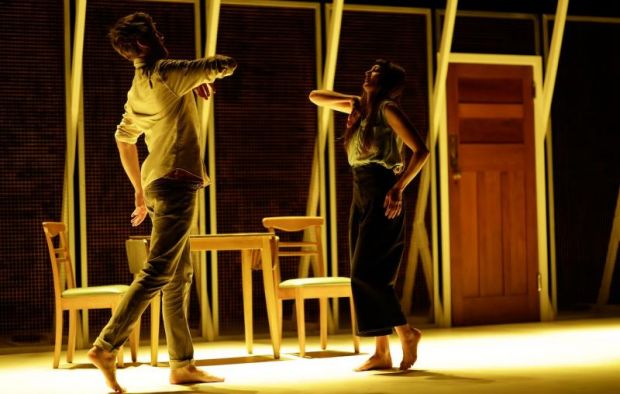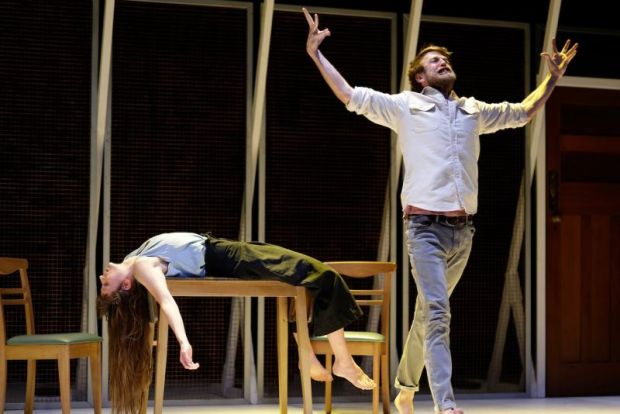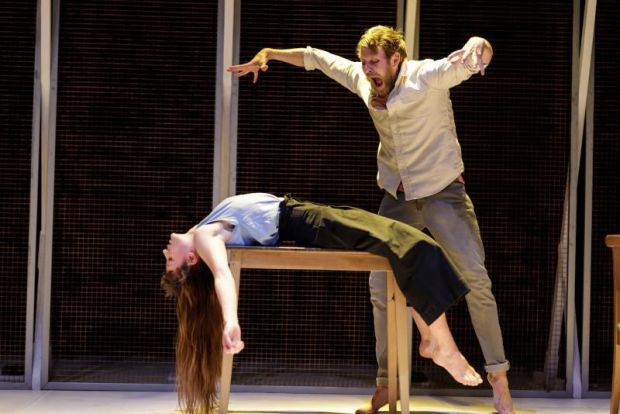Juliet & Romeo
It is twenty years since the familiar events of this couple – except neither Juliet nor Romeo died. Instead, they ran away to Paris, got married, had a daughter, and now… well, now they are having relationship difficulties. And after trying every kind of therapy to salvage the marriage, they are here in the full auditorium, to try a kind of group therapy session, where they share with us their history, as each of them remembers it.
This beautiful production from Lost Dog retells the well-worn story of star-crossed lovers through monologue, conversation, and dance. Conceived and directed by Ben Duke, it’s an intelligent exploration of love, loss – and love lost. As Duke tells us, ‘the problem with cheating death is that you have to carry on living’, and that initial love (and lust) hasn’t survived the two decades since it was originally inspired.

Solène Weinachter is Juliet, apologising for her rich French accent at the start of the performance, when there’s really no need given how much it enriches her passionate character. Weinachter (who also devised the performance with director Duke) is brilliant in her storytelling, both when relating her memories and correcting those of her husband, Romeo.
Kip Johnson is a very different Romeo, with his all-English confusion and apology, yet the dramatic awkwardness dissolves to flowing dance when the music starts. Which it does often, using classical and contemporary melodies and lyrics to relive their past: their first encounter, remembered differently by each of them; or the alternative to Shakespeare’s narrative playing out in the vault. Their movement can be elegant and graceful one moment, then violent and disharmonious the next, but it’s constantly and perfectly breathless. It succeeds in being tremendous visual art and emotional storytelling. It looks great, and it feels strongly, from euphoria to pain.

Together, Weinachter and Johnson can have so much chemistry and synchronicity that you begin to question where the relationship isn’t working: the way they look at each other, the way they act out their memories, laced with love, not poison. But then they break from their ‘play within a play’, and there’s the fire, there’s the conflict – there’s the anger, resentment, sadness, selfishness. How these two individually turn on one another so quickly is familiar to those of us who have experienced a relationship breakdown, the snapping of their taut and tenuous connections under stress is completely real and utterly heart breaking. What this story does so well is to show us how things crumble when the foundation isn’t truth; how unspoken thoughts can sharpen over time, to become a lethal knife.

The incorporation of Shakespeare and his version of events is cleverly turned inside out in this story, his famous lines hilariously misappropriated to tell the lovers’ stories. Yet when they act out their memories using the Bard’s words, rather than their own, there is a different kind of light to their faces, it’s a different form again – almost a play within a play within a play.
Lighting by Jackie Shemesh gives shape to James Perkins’ minimalist set – both are strong, but their simplicity permits the strongest illumination to come from Johnson’s and Weinachter’s captivating performances, which are beautiful, laugh out loud funny, crushing, crashing, and tragic.
Mark Wickett
Photographer: Tim Standing

Subscribe to our E-Newsletter, buy our latest print edition or find a Performing Arts book at Book Nook.

